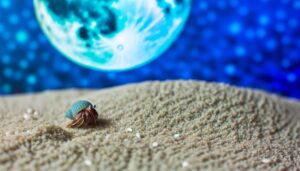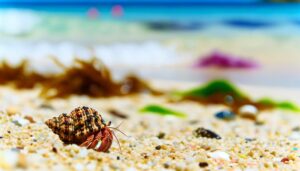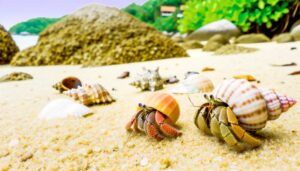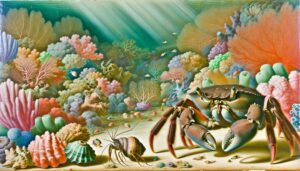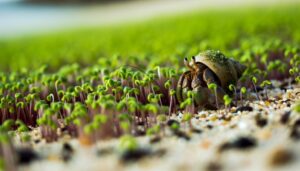How to Identify Different Types of Blue Crabs
You have several intriguing species to explore. The Caribbean Hermit Crab thrives in high humidity, constantly changing shells.
The Coconut Crab, noted for its air-breathing gills, prefers coastal forests. Ecuadorian Hermit Crabs forage day and night in coastal habitats.
Blue Leg Hermit Crabs stay in shallow reefs and consume algae and detritus. Strawberry Hermit Crabs need high humidity and frequently switch shells.
The Halloween Hermit Crab's striking colors and burrowing habits make them unique. Finally, the Giant Land Hermit Crab, reaching up to 4 kg, climbs trees and grazes on coconuts.
Each species offers distinct behaviors and habitat needs to uncover.
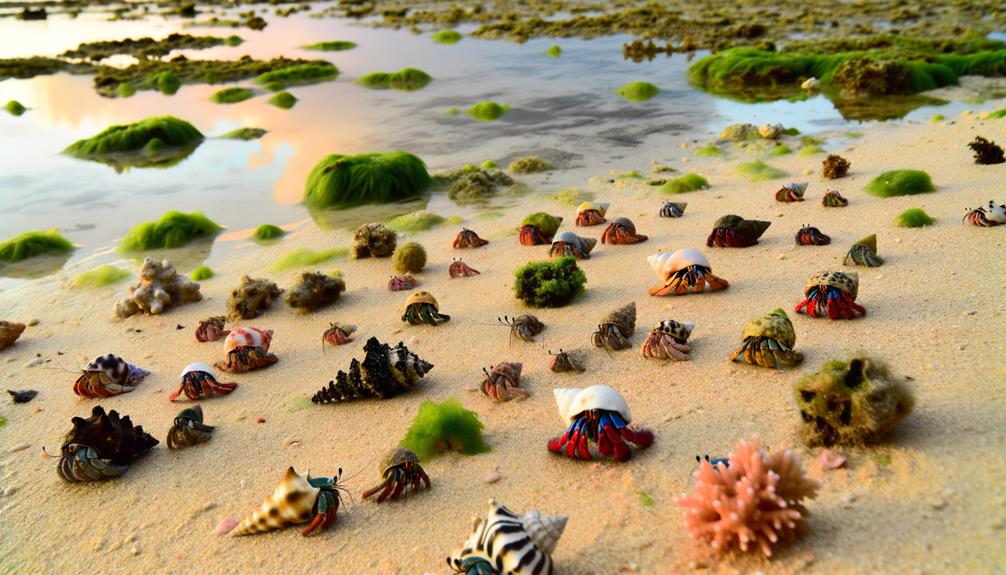
Key Takeaways
- Caribbean Hermit Crab thrives in humid environments and is nocturnal.
- Ecuadorian Hermit Crab can forage both day and night and needs both fresh and saltwater.
- Blue Leg Hermit Crab lives in shallow reefs and feeds on algae and detritus.
- Giant Land Hermit Crab can grow up to 4 kilograms and climbs trees for coconuts.
- Halloween Hermit Crab requires a mixed substrate for burrowing and a diet of commercial food and fresh produce.
Caribbean Hermit Crab
The Caribbean Hermit Crab, scientifically known as Coenobita clypeatus, primarily inhabits tropical coastal regions and is characterized by its adaptive exoskeleton utilization.
You'll find them in environments with high humidity and temperatures ranging from 24°C to 30°C.
Their distinctive behavior involves occupying discarded gastropod shells, which they periodically change as they grow.
These crabs are omnivorous, consuming a diet that includes fruit, vegetation, and decaying matter, thus playing an essential role in nutrient cycling.
They exhibit nocturnal activity patterns, which means they're most active during the night.
Coconut Crab
You'll find Coconut Crabs primarily in coastal forests across the Indo-Pacific region. Their diet consists mainly of fruits, nuts, and carrion, with an unprecedented ability to crack open coconuts using their powerful claws.
Understanding their habitat preferences and feeding behavior can provide insights into their ecological impact and conservation needs.
Habitat and Distribution
Coconut crabs mainly inhabit coastal regions of islands in the Indo-Pacific, particularly favoring areas with abundant coconut palm trees. You'll find them distributed across numerous islands, including Christmas Island, the Seychelles, and parts of Indonesia. They prefer terrestrial habitats, often burrowing in sand and soil near the shore.
These crabs are highly adapted to land, with specialized gills that allow them to breathe air. Their habitat selection is driven by the availability of coconut palms, which provide both food and shelter. By understanding their distribution, you can contribute to conservation efforts, ensuring their habitats are protected from deforestation and human encroachment.
Data indicates that habitat degradation significantly impacts their population, emphasizing the need for targeted environmental stewardship.
Diet and Feeding
Understanding their habitat and distribution highlights the significance of their diet, which mainly consists of fallen fruits, nuts, seeds, and occasionally carrion. Coconut crabs (Birgus latro) exhibit an omnivorous dietary pattern, essential for their growth and survival. They possess powerful pincers capable of breaking open coconuts, a primary food source, hence their name. Studies indicate their diet comprises approximately 50% plant material and 30% animal matter.
The remaining 20% includes opportunistic feeding on carrion and other available nutrients. You should make sure their captive diet mirrors this, providing a balanced mix of fruits like papaya and nuts such as almonds. Avoid foods high in salt and artificial additives, as these can negatively impact their health and lifespan.
Ecuadorian Hermit Crab
You'll find Ecuadorian Hermit Crabs exhibit a range of color variations from vibrant red-orange to subtle brown hues, typically measuring between 12 to 40 millimeters. These crabs occupy coastal habitats and demonstrate a preference for moist environments, frequently engaging in burrowing behavior.
Significantly, their activity patterns include both diurnal and nocturnal foraging, adapting well to varying tide schedules.
Color and Size Variations
Ecuadorian hermit crabs exhibit a wide range of color variations, from shades of brown and orange to vibrant reds and blues, with adult sizes typically ranging between 12 to 20 millimeters.
You'll notice that these color differences can be indicative of their health and environmental conditions. For instance, healthier Ecuadorian hermit crabs often display more vibrant hues.
Their size, while relatively small, allows them to inhabit a variety of shells, providing flexibility in their living conditions.
Accurate measurement of their size and color can aid in ensuring ideal care, as changes may signal nutritional deficiencies or stress.
Monitoring these parameters diligently enables you to create an environment that promotes their well-being, fulfilling your commitment to their care.
Habitat and Behavior
The habitat of Ecuadorian hermit crabs typically includes moist, coastal regions with access to both fresh and saltwater, facilitating their essential molting and hydration needs. It's important that their environment replicates these conditions.
They thrive in temperatures between 72°F and 85°F and require humidity levels of at least 70%. Providing a substrate mix of sand and coconut fiber allows for burrowing and moisture retention.
Behaviorally, they're gregarious and prefer living in groups, exhibiting social interactions such as shell exchanges. These crabs are nocturnal, becoming more active during the night when they forage for food.
To maintain their well-being, offer a diet rich in protein and calcium, including commercial hermit crab food, fresh fruits, and seafood.
Blue Leg Hermit Crab
Among popular marine invertebrates, the Blue Leg Hermit Crab (Clibanarius tricolor) stands out for its vibrant coloration and efficient algae-cleaning capabilities. You'll find its striking blue legs and orange antennae make it a visually appealing addition to any marine aquarium. Known for their algae consumption, these crabs help maintain a clean and balanced marine ecosystem. They exhibit a preference for empty shells, allowing them to grow and adapt effectively.
| Parameter | Specification |
|---|---|
| Scientific Name | Clibanarius tricolor |
| Size | Up to 1 inch |
| Diet | Omnivorous, algae, detritus |
| Habitat | Shallow reefs, rocky substrates |
| Lifespan | Approximately 2-4 years |
These crabs are excellent for community tanks, promoting environmental stewardship by regulating algae growth. Their compatibility with other marine life ensures a harmonious aquarium environment.
Strawberry Hermit Crab
Characterized by its vibrant red exoskeleton, the Strawberry Hermit Crab (Coenobita perlatus) thrives in coastal environments and requires specific care to maintain its striking appearance.
You need to provide a habitat with temperatures between 75-85°F and humidity levels around 70-80% to mimic their natural conditions. Ideal diet includes fresh fruits, vegetables, and protein sources such as fish or shrimp. Regular access to both saltwater and freshwater is essential for their osmoregulation.
Make sure their enclosure has plenty of climbing structures and substrates like sand or coconut fiber for burrowing. Frequent shell upgrades are necessary due to their rapid growth.
Halloween Hermit Crab
Identified by its striking orange and black coloration, the Halloween Hermit Crab (C. clypeatus) demands a habitat with temperatures between 75-85°F and humidity levels of 70-80% to thrive.
You'll need to guarantee the enclosure includes a substrate mix of sand and coconut fiber at a depth of 4-6 inches to facilitate burrowing.
Ideal tank size starts at 10 gallons for one or two crabs, scaling up accordingly. They require both fresh and saltwater sources for hydration and molting.
Diet should consist of high-quality commercial crab food supplemented with fresh fruits, vegetables, and proteins.
Regular monitoring of environmental parameters and diet will optimize the Halloween Hermit Crab's health and longevity, enabling you to provide the finest care possible.
Giant Land Hermit Crab
The Giant Land Hermit Crab (Birgus latro) grows to an impressive size, often reaching up to 4 kilograms in weight and 40 centimeters in length, making it one of the largest terrestrial invertebrates.
You'll find these crabs mainly in coastal regions of the Indian and Pacific Oceans. They exhibit a unique behavior: climbing trees to harvest coconuts, a primary food source.
Adaptations like strong pincers and a specialized exoskeleton aid in traversing rugged terrain.
Birgus latro's reproductive cycle involves females releasing eggs into the ocean, where larvae develop before shifting to land.
Their longevity, often exceeding 30 years, makes them a critical component of their ecosystems, playing roles in seed dispersal and soil aeration.
Australian Land Hermit Crab
Inhabiting the diverse coastal and island ecosystems of Australia, the Australian Land Hermit Crab (Coenobita variabilis) showcases remarkable adaptability in its behavior and habitat selection. You'll find these crabs mostly in intertidal zones, where they utilize empty gastropod shells for protection. They exhibit a preference for moist environments, ensuring their gills remain functional for respiration.
These hermit crabs are nocturnal, optimizing their foraging efficiency and reducing predation risks. Their diet consists of detritus, algae, and small invertebrates, contributing to the ecosystem's nutrient cycling. Reproduction occurs in the ocean, where larvae undergo several planktonic stages before shifting to terrestrial life.
Conclusion
In exploring the diverse world of hermit crabs, you've encountered species like the Caribbean Hermit Crab and the striking Halloween Hermit Crab.
Each has unique adaptations, from the Coconut Crab's formidable claws to the Blue Leg Hermit Crab's distinctive coloration.
By understanding their varied habitats and behaviors, you gain a deeper appreciation for these fascinating creatures.
Just as a hermit crab seeks the perfect shell, you've gathered knowledge to enhance your understanding of their complex, mesmerizing lives.

